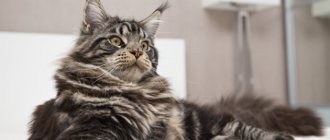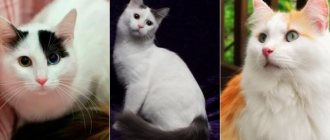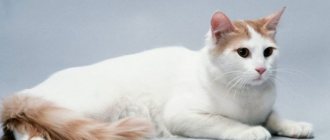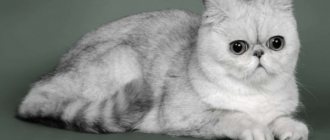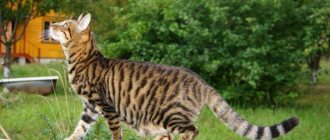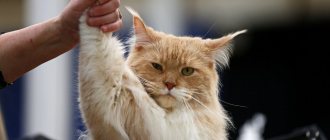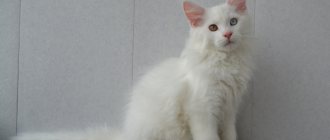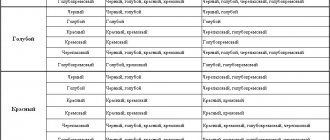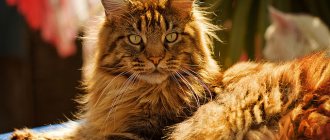Maine Coons are the largest domestic cats. While there is a strong demand for miniature breeds among dogs, the opposite trend is observed among cats. People want to see at home, if not a tiger, then at least a lynx. Therefore, giant cats with tassels on their ears are in great demand.
Stories about Maine Coons and their unusual appearance do not make the right impression. Weighs 12 kg? Yes, we fed the yard Barsik up to 10 kg, just think. Oh, how wrong those of little faith are. Only when you see a cat about a meter long, without a drop of fat on his muscular body, in a cloud of luxurious fur, do you understand what a Maine Coon is.
Then there are questions that are funny for breeders - won’t he eat us? What about the dog? What about children? Should I feed him raw meat? And so on, endlessly. But my eyes are already burning, I can’t get rid of the thought - what if... I wish I had something like that!
Maine Coons became popular precisely because of their brutal appearance. This cat is an oasis of wild nature in a city apartment. Add to this their amazing character and ability to become a real companion - the high price of kittens has not stopped anyone for a long time, the army of Maine Coon fans is growing every day. A description of the Maine Coon breed will help you understand whether such a pet is right for you.
Author of the article: Olga Shiltsova, practicing veterinarian, author of the books “Dachshund of Fate” and “Tails of Fortune”
The origin of the breed without beautiful fairy tales
Maine Coon is the national pride of Americans. This name consists of two words - the name of the state of Maine (Maine) and the ending coon - translated as raccoon (short for raccoon). In Russian it would be better to say “raccoon cats from Maine.”
This second “raccoon” prefix was only added in the 20th century, due to the only wild color recognized at that time - the brown tabby, striped, resembling the skin of a raccoon. Needless to say, raccoons did not take any part in the formation of the breed, since they are a biological species incompatible with cats.
I may not be a raccoon, but I will be a crayfish!
Maine Coons are aboriginal cats, formed without the active participation of humans. Due to their resemblance to the Norse Forest breed, some argue that the Vikings brought the furry cat to North America in the 2nd century.
It’s hard to say about the Vikings, but sailors of all nations definitely brought cats to the continent - without a staff cat there would have been no rats on the ships. Descendants of large ship rat-catchers spread from the state's ports inland.
Wild cats have lived in North America for centuries. It was with these short-haired animals that long-haired cats imported from Europe began to crossbreed.
Maine has a harsh climate with cool summers and long winters. Cats obtained their own food and defended themselves from predators. The result of harsh selection was unusually long fangs, a long and wide muzzle with a powerful lower jaw.
Maine Coons remain good hunters
In response to the cold climate, Maine Coons developed a lush undercoat and long, waterproof outer coat.
Luxurious fur
Large forest hunters themselves populated barns and stockyards in the vicinity of human habitation. The settlers, noting the effective extermination of rats, began to tame these cats, take them into their homes and lovingly care for them. This happened in the 19th century.
Even then, Americans loved everything big, and Maine Coons began to migrate from villages to cities, successfully participating in exhibitions. In 1878, there were 10 Maine Coons at a cat show in Boston. However, then the Persians knocked them off their pedestal, and from 1911 to 1951 not a single cat from Maine was registered at exhibitions.
In 1953, a club of breed lovers was created in the States, and in 1968, Maine Coon breeders united in the Association, which still exists. Breed standards were established in 1976, and by 1980 at least 200 kennels were registered. The popularity of coons begins to increase every year; they now occupy 2nd place in the ranking of breeds of the CFA Association of Cat Fanciers.
Love that tail!
In 1989, the first Maine Coons appeared in Russia. There were so few of them that breeders traveled abroad for breeding. Now the situation is improving, but animals are still brought from European countries and the USA.
Interesting Facts
- Life expectancy 12-15 years
- Sleep up to 20 hours a day (14-16 average)
- Height 30-40 cm, length up to 1 meter including tail
- A Maine Coon cat named Pebbles starred as Mrs. Norris (Argus Filch's cat in the Harry Potter films)
- The longest cat in the world is Maine Coon Stewie - 123 cm from the tip of the nose to the tip of the tail.
- The longest whiskers 19 cm – Maine Coon cat Missy
Severe forest dweller: appearance of Maine Coons
There are strong differences in the appearance of males and females. Kitties are more graceful, weighing only 4-8 kg, and the weight of adult cats can reach 10-12 kg. The gigantism of Maine Coons is greatly exaggerated; the average weight of a cat is 7-9 kg. Even though some manufacturers reach a weight of 14 kg, this does not mean that the pet will weigh the same.
Maine Coons are one of the largest domestic cats!
The long muscular body looks harmonious, the coons are proportionally built. They have powerful paws, and a lot of fur between their toes: their paws resemble snowshoes.
In addition to their size, Maine Coons are distinguished by their luxurious coat. An incredibly long and fluffy tail that a cat can wrap itself in while sleeping. The length of the tail is equal to the length of the body.
The coat consists of a light curly undercoat and dense, smooth guard hairs, which reach 10-15 cm in some areas. Coons have long fur on their bellies, fluffy fur panties, and a collar (mane) around their necks.
Relative to the body, the head looks small. The large ears are decorated with long tassels, making the cat resemble a lynx. There are tufts of hair in the ears. Maine Coons have a longer muzzle than most domestic cats. A wide nose and a massive chin, like a tiger or a lion - the whole appearance indicates that this is a predator, a hunter.
Wide nose and massive chin. Maine Coon cannot be confused with anyone else.
Nowadays Maine Coons come in all colors except Siamese (color point). The traditional wild color is agouti (spotted-striped), but in Russia you can find pure white or pure black Maine Coons. Eye color can be any.
Black Maine Coon kitten
White coons have an unusual phenomenon - heterochromia, when the cat has eyes of different colors. You can read more about this and see photos of odd-eyed cats HERE (the link will open in a new tab).
White Maine Coon kitten
Like large dogs, large cats mature slowly. The Maine Coon is considered mature and formed only at 3 years old.
Maine Coon weighing 12 kg
A big cat has a big heart: the character of Maine Coons
The power and nobility of these cats are combined with a good-natured character. They easily get along with cats and dogs and babysit children. Breeders say that cats do not have to be isolated from a nursing cat: males not only do not harm the kittens, but also take care of them along with the mother.
The massive British woman looks tiny next to the coon.
Maine Coons are attached to their owner, they try to accompany him everywhere, but they never impose their company. Independent cats with self-esteem, delicate and calm.
Petting these gentle giants is a pleasure - they are responsive to affection. But these cats don’t like to sit on their hands - apparently, they don’t have enough space on their laps, and when they’re in the air, it’s difficult to trust weak human hands.
There are exceptions to every rule: this Maine Coon is basking in his owner's arms
Unlike the sedate British, Maine Coons are very active and love to play. Hunting instincts require implementation, and cats enthusiastically catch a ball or a toy mouse. Coons can be taught various tricks and respond not only to their name, but also to a conditioned signal.
His Catness plays with a teaser fishing rod
Giant albino squirrel? No, young Maine Coon cat
The breed has high intelligence. Cats quickly remember individual words, sensitively pick up intonations, even gestures and facial expressions. They adapt to their owner's mood, and people adore them for this ability.
As a veterinarian, I am always amazed at how patiently Maine Coons endure various procedures without ever attempting to bite their owner.
Allergenic or hypoallergenic?
Maine Coons can cause allergies, since the cause is not the fur, but the substances that the animal’s skin secretes. If the cat owner is prone to allergies, then sooner or later he will react to the new pet. But Maine Coons cannot be called hypoallergenic: allergies are caused by feces, saliva, and gland secretions of this breed.
The allergenicity of the breed does not depend on the length of the animal's fur. The enzyme, not the vegetation, causes the painful reaction.
Is it difficult to keep a Maine Coon?
Wool. Maine Coons have a lot of fur. Owners experience problems with shedding. The coat is renewed throughout the year, and seasonal shedding is a real wool tsunami. To prevent your pet from forming tangles in the armpits, on the stomach, behind the ears and on the pants, regular brushing is necessary. Some Maine Coons have the hair under their tail trimmed to prevent it from becoming contaminated with feces.
Do you think this is funny, man?
Furniture can be destroyed very quickly by the Maine Coon's powerful claws. The apartment should have several scratching posts, adjusted for the impressive size of the animal. Otherwise, the Maine Coon will knock over the scratching post or will not be able to stretch out to its full height. It is best to secure a real log in the room. You can adjust the length of the nails by trimming them with a nail clipper 1-2 times a month.
Big cat needs a big scratching post
Healthy animals do not have discharge in the corners of the eyes or inside the ears, and there is no need to wipe them. But you need to accustom your kitten to dental care from childhood. You need to brush your teeth and massage your gums once a day using a finger brush and a special paste for cats.
Only show animals have to be bathed; other Maine Coons can do without water treatments. You cannot wash your pet later than a week before the exhibition, otherwise the coat will not have time to recover.
In general, all maintenance problems are associated only with the long hair of these cats and their gigantic size. For example, you must have room for a huge litter tray. Which will require a lot of filler. A Maine Coon poops not like an adult, of course, but like a small child for sure.
What should you play, madam?
The more a cat weighs, the more food she needs. In other words, instead of one Maine Coon, you could feed three slim Thai girls. The diet is either natural food or high-quality feed. Both of these don't come cheap.
Let's take Now Natural Holistic food. A cat weighing 3.5 kg needs about 50 g per day (1.5 kg per month), and a Maine Coon weighing 7.5-9 kg already needs 115-170 g - this is 4.5-5 kg of food per month at a cost about 700 rub. for 1 kg.
Care and maintenance
The main thing in keeping a Maine Coon is space
.
A large animal necessarily requires sufficient territory to live. A balanced diet
is a must .
The Maine Coon matures and grows slowly. To form strong bones and strong muscles, you need a sufficient amount of high-quality protein in the diet, vitamins and microelements. Regular physical activity
and walking will help maintain your endurance level, strengthen your spinal muscles and train your heart muscle.
The Maine Coon's coat
, although not prone to rolling, requires regular care, combing, and washing.
Hygiene of ears, eyes, and claws
prevents inflammatory and fungal diseases.
Anthelmintic
treatment and regular
vaccination
are required to maintain proper animal health.
Hereditary diseases of Maine Coons: it is important to know
Popularity played a cruel joke on the breed - amateurs began to breed Maine Coons, crossing them uncontrollably. Extremely long cats with weak bones and problem joints, or small individuals with weakly expressed breed characteristics, appear. If you have already chosen this breed, take a kitten with a pedigree. This is not a guarantee of an exhibition career, just information about ancestors up to the 4th generation. Take a fully vaccinated, healthy baby at 3-3.5 months. Look at the conditions in which the kittens were kept, do not agree to meet “near the metro”.
Maine Coon kitten
Some hereditary diseases have become established in the breed:
- HCM – hypertrophic cardiomyopathy.
This heart disease causes the sudden death of young cats, sometimes caused by neutering surgery. Before general anesthesia, all Maine Coons need to have a cardiac ultrasound (ECHO), and ideally, it should be done every year until they are 4-6 years old, even if no surgery is planned. The same defect occurs in British breed cats.
- Spinal muscular atrophy.
The first signs of this disease appear at 3 months - muscle weakness and trembling are noticed in the kitten. By six months, the pet becomes clumsy, staggers when walking, and cannot jump on and off.
Although muscle atrophy in this disease is constantly progressing, some animals live up to 7 years. But such a life cannot be called fulfilling.
- Erythrocyte pyruvate kinase deficiency.
Hereditary anemia. The cat's red blood cells are destroyed, which eventually leads to death. The disease begins to appear between the ages of six months and 5 years. The pet becomes lethargic, appetite disappears, and diarrhea develops. The variety of symptoms makes it difficult for doctors to make a correct diagnosis. The same disease occurs in Abyssinian cats.
- Hip dysplasia.
Congenital disorders of joint development are becoming more common in Maine Coons. This leads to early arthrosis and chronic pain.
- Gingivitis.
Maine Coon kittens are predisposed to juvenile gingivitis. Severe redness of the gums is noticed at 6-8 months. The disease may subside by age 2 with proper treatment.
If a cat's gum inflammation is autoimmune in nature, then the only effective treatment is the removal of all teeth except the canines.
In addition to hereditary diseases, young Maine Coons develop osteodystrophy (nutritional hyperparathyroidism) if fed improperly.
If you take a kitten from a responsible breeder, you can hope that the Maine Coon will be free from genetic defects and will live a long life - 15-16 years. Rarely anymore, the breed is not long-lived like Persians or Siamese.
Cost, nurseries, documents
The cost of a Maine Coon depends on the class of the pet. Purebred animals that meet all breed standards and are suitable for an exhibition career will cost their owner from 50,000 to 120,000 rubles. In the price range from 20,000 to 50,000, animals with slight deviations from the standard, but suitable for breeding, are sold. The cheapest animals are considered to be pet class animals, simply pets.
They are not suitable for participation in exhibitions and cannot produce purebred offspring, while their character and appearance remain entirely Maine Coon. Nurseries are engaged in breeding the breed, clearly monitoring the breeding process. To get a purebred animal with all the documents, you need to contact the breeder directly.
When buying a Maine Coon "from hand" - at a bazaar or poultry market - there is a high probability of forgery and false documents.
Kennels present their animals for exhibitions, and in the pedigree they clearly indicate all the relatives of the animal and its family tree.
Owner reviews
“I dreamed of a Maine Coon for several years, but ordinary cats lived with me all my life. But a couple of years after the arrival of the long-awaited kitten, I greatly regretted it. I can’t stop him from climbing tables and cabinets and stealing food. Wool is everywhere, I no longer have the energy to clean it up. Food expenses are quite significant, and the tray takes up half of the hallway. So he also digs like an excavator, scattering the filler. He destroyed all my repairs - not only with his claws, he also likes to chew on everything, especially wires. I changed the curtains several times, they were all torn. So think before you adopt a Maine Coon – all the problems that can be associated with cats will have to be multiplied by three.”
“Tyson looks menacing and looks angry, but in reality he won’t offend anyone. He doesn’t recognize tenderness, he keeps his distance, but he always comes to bed and can almost lie on his head. Smart, noble, but not arrogant. Ideal!"
“I adore my kunator, but my Timofey is such a pig! He always scatters food around the bowl, and he also likes to scoop up water with his paws. He doesn't go to the potty carefully, I clean his fur pants every day. Everyone's tail catches garbage. Another peculiarity is that he constantly takes funny poses! At first I constantly ran after him with a camera. When he sleeps, it’s absolutely something. A favorite of the whole family, all pranks are forgiven."
“My husband is sure that our cat understands human speech. She often pesters us to play, even though she is already 3 years old. I don’t understand the worries about fur – what did you want from a long-haired cat? Tosya is no more troublesome than an ordinary cat, our pride and joy. We were choosing between Maine Coons and Norwegians, we are very glad that we finally got a Maine Coon.”
“The cat never scratched my little daughter, although she periodically pestered him. If he doesn’t like something, he simply goes to the top (they made him a cool climbing complex). Maintenance costs about 5 thousand a month, which may seem like a lot to some, but it’s normal for us, we knew what we were getting into. When guests arrive, at first everyone talks only about the cat, he attracts everyone’s attention.”
Who is Maine Coon suitable for?
Maine Coons can live in city apartments, but it is ideal to keep such a pet in a country house with its own enclosed territory, or go with your pet to the countryside during the warm season. These active cats need to exercise a lot to avoid gaining excess weight and keep their muscles toned. If you live in an apartment, decide right away what is more expensive for you - a cat or repairs.
The Maine Coon is not a couch cushion. These are active cats.
The breed is suitable only for people with high, stable income. You can’t save for several years for the kitten of your dreams and hope that the expenses will end there. You should choose a Maine Coon from a reputable cattery to avoid genetic health problems.
If you have a Maine Coon at home, help fill out the description of the breed! Tell us in the comments about the features and character of your pet.
Some causes of mustache breakage
The reasons can be very diverse. Here are some of them .
Dry air in the apartment. When the air in the house is too dry, especially in the winter season when there are a lot of heating devices, this can cause the cat's whiskers to break. Unfortunately, not a single cat is immune from this; you just need to try to help it.
Frequent bathing and poor-quality shampoos. Excessive water procedures, especially with poor quality cosmetics, leads to seborrhea, a painful skin condition. This can also cause the mustache to break off and even fall out.
Adolescence in a cat provokes a temporary metabolic disorder, as a result of which the whiskers can also break.
